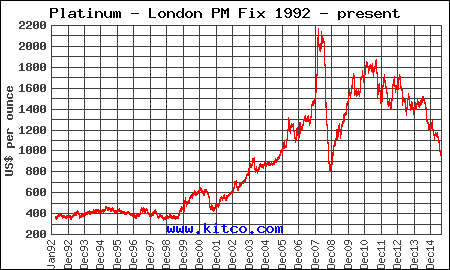After nearly five years of a correcting bear market, platinum prices have fallen by nearly half, from $1,800 in 2010 to $1,003 on Sept. 8.
Platinum prices climbed to $1,800 in their two-year rebound following 2008's financial crisis. The crisis sent platinum all the way down to $800 by December that year - a 64% plunge from its all-time high of $2,250.
But since 2010, it's been mostly a long grind downward as the global economy struggles to eke out even minor growth.
Platinum prices have cratered on weak demand. In order to stem the tide, some of the world's largest producers of the precious metal are cutting production.
What comes next - highlighted in a new report - should help platinum find its footing...
Production and Workforce Cuts Signal a Bottom for Platinum
A report released Aug. 12 by the World Platinum Investment Council (WPIC) gave investors a look at where the platinum market is headed.
WPIC said platinum production in South Africa, the world largest producer, will drop by 600,000 ounces next year - a massive 16%. That brings the country's output to 3.4 million ounces in 2016 versus an expected 4.06 million ounces in 2015.
In fact, capital investment has fallen 63% since 2008 as platinum output has declined. That's $1.5 billion of funds to operate that simply didn't get invested. In a few years, that lack of capital will manifest in severely challenged supplies when demand is forging ahead.
One producer alone, Lonmin, said it would cut production by 100,000 ounces annually.
And then came even more sobering news.
According to Bloomberg, Glencore Plc. (LON: GLEN) will shutter its Eland platinum mine, also located in South Africa.
Glencore produces platinum from two mines in the country for a total of 157,000 ounces annually. So closing one of its mines will make a huge dent in production.
In North America, Stillwater Mining Co. (NYSE: SWC) announced it will lay off 119 workers (7% of its total workforce) in an effort to rein in production costs. The platinum and palladium producer had already cut its workforce by 9% over the previous year.
So what does all this mean for the platinum market?
We could well be approaching a bottom in the precious metal's price. That's because South Africa, currently responsible for 68% of world supply, also faces labor challenges.
And yet a recent agreement between mineworkers and major platinum producers will see wages rise 7% to 10.5% over the next three years.
This will put more pressure on platinum miners to cut jobs and make further productivity gains. According to Roger Baxter, head of South Africa's Chamber of Mines, more than 50% of the nation's mines currently operate at a loss.
Meanwhile, big money is flowing into platinum exchange-traded funds as investors recognize a bargain.
"These inflows suggest that they see value at prices approaching $1,000 an ounce," said David Jollie, head of research at Mitsui & Co. Precious Metals Inc.
Assets in these funds are close to record levels, indicating elevated interest in platinum at current prices.
And one more new development could also shake things up in the platinum world...
This News Could Be a Game-Changer for Platinum Prices
A major agreement between South Africa's mining industry, unions, and government meant to limit job losses also has another goal.
According to Reuters, which saw a draft, the agreement will encourage BRICS nations - Brazil, Russia, India, China, and South Africa - to hold platinum as a reserve asset in their central banks.
Platinum is a small market. Government purchase of the metal as a reserve asset would have a drastic effect on supply.
World platinum production is highly concentrated. South Africa is responsible for 68%, Russia for 15%, and Zimbabwe for 7%.
If South Africa alone begins central bank stockpiling of platinum, it would have a huge impact on available supply. But if Russia and even Zimbabwe do the same, the effect would be intense.
It would be like an OPEC of platinum producers. And with the current weakness in those nations' economies, a favorable response to this idea is not unheard of.
Given the challenges the platinum industry has faced over the last several years, a possible multiyear low is now looking closer than ever.
In fact, at $946 in early August, we may have already seen the bottom in platinum prices.
Follow us on Twitter: @moneymorning.
Gold Prices Are Still Low... And they offer one of the best chances to buy gold we've seen in a decade. But not all gold is created equal - and the same applies to gold investments. Here's everything you need to consider when buying gold...




